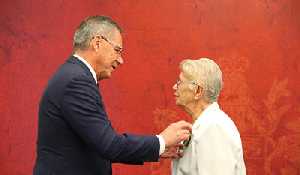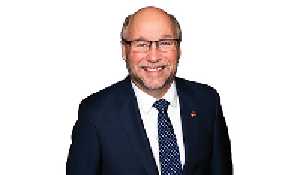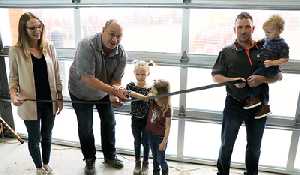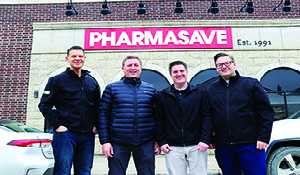RQHR hoping to hire two new doctors in Moosomin
February 10, 2015, 2:10 am
Kara Kinna


The emergency services at the Southeast Integrated Care Centre in Moosomin could see reduced services from time to time until more doctors can be found to work in Moosomin.
According to Dr. Ross Kerkhoff, Moosomin is presently working with seven physicians—three part-time and four full-time—but is about to lose one of its full-time physicians. However, Kerkhoff says, there is a chance the town may be getting two new doctors in June.
Until then, emergency services could be reduced at times. In December, the Moosomin Family Practice Centre announced there would be interruptions in the emergency services at the SEICC commencing on Dec. 22 due to physician shortages.
The first interruption took place on January 21, when it was announced that emergency services at the SEICC would be temporarily reduced for three days. However that reduction in services only lasted for a few hours, and was quickly lifted.
Kerkhoff explains that “reduced services” does not mean emergency services are closed. It simply means that someone else—such as a nurse practitioner or paramedic—is temporarily available when a doctor is not. In most cases, a doctor still is available on backup if they are needed. Kerkoff says services are only reduced in certain instances.
“If someone is on call the whole weekend—Friday, Saturday and Sunday—and there’s no one to do the Monday, it’s not safe for that doctor to do four days in a row,” he says.
“In the interim we’ve been using some nurse practitioners with physician backup, and also some paramedics with physician backup, and also recruiting some locums out of Regina to assist us.
“It’s a different model, which we all need to get used to, to adapt.”
Kerkhoff says the emergency services was still operational on January 21 during the brief time that services were reduced.
“There was a nurse practitioner and one of us was on back up. So it was never closed, it’s just that the model changed,” he says.
He says all other services in Moosomin were fully operational that day as well. “All our clinics were operational and the open access clinic was operational.”
Kerkhoff says the reason for using nurse practitioners, locums, or paramedics when a doctor is not available for the emergency services is to ensure that Moosmin’s emergency services continue to be operational as opposed to limiting services altogether.
“What we are trying to avoid is running into the same issue as all the other community hospitals in our area, vis-a-vis Virden, Redvers, etc. Redvers has had limited service for a while,” he says.
“There are certain challenges we have to meet, and it’s all to continue the 24-hour service and to ensure we don’t go down the same path as other smaller community hospitals.”
Kerkhoff says Moosomin serves too wide of an area for the emergency services to be suspended.
“It just services too large of an area and provides emergency services for this area. With the southeast corner here with the economic and population growth, it’s a necessity that it stays open. It’s just a matter of how we get the staff and resources to do that.”
Karen Earnshaw, the Vice-President of Integrated Health Services with the Regina Qu’Appelle Health Region, says Moosomin has rarely had to see reduced emergency services.
“It’s not unlike the kinds of things that happen in other communities, it’s just that in Moosomin we haven’t been experiencing it up to this point, but certainly other communities have,” she says.
“It is our goal to never reduce services in a community unless we’ve exhausted all the other options. That’s exactly what we continue to do with Moosomin. So we’re actively working with both the physicians and the other providers who contribute to the service. And we know our long-term plan is to recruit additional providers such as physicians.”
Earnshaw says until more doctors can be recruited for Moosomin, a number of care providers are available to cover the emergency services when the Moosomin doctors are not.
“We use locums, so we solicit other communities, other physicians who maybe work in other parts of our region. I know we’ve gotten some interest from somebody who works out of Regina, and then we’ve gotten some physicians in the past who have been used to coming to Moosomin that work in the emergency room, and we will continue to use them.
“We’ve also had some interest out of the physicians practicing in Redvers. So they are starting to come up to Moosomin, too. They currently don’t have registered nurses to be able to provide emergency services in Redvers, so while they are having service reductions, those physicians are prepared to come (to Moosomin).”
Both Kerkhoff and Earnshaw say that this is only a temporary solution, and good news is on the horizon for Moosomin. Through the Saskatchewan International Physician Practice Assessment (SIPPA) program, which allows international medical graduates to practice medicine in Saskatchewan, there are plans to have two new doctors in place in Moosomin by June, providing that they are accepted.
Earnshaw says the health region is also looking for a full-time nurse practitioner to work in Moosomin.
“The increased ability for foreign-trained physicians to be assessed by the college, get their licensing, that’s opened up the door for recruitment really in rural areas,” says Earnshaw.
“In the last year we have recruited nine physicians via the SIPPA program. And we actually had two candidates out to Moosomin this week. They toured, met the physicians, met the staff, and they are entering into the program shortly. If they are successful they would be ready and able to start practicing in Moosomin in June.”
“We’re also recruiting for a full-time nurse practitioner for that facility as well. This would be just another additional service.”
Earnshaw says because health care clinics are not accessible seven days a week in many parts of the province, including Moosomin, many patients use the emergency services for their every day health care needs. Ideally, she says, with enough care providers, it would be nice to see pressure taking off the emergency services in the long-term.
“When you can get access to primary health care seven days a week, then that starts to change what you need to resource the emergency room,” she says.
“Ideally we’d have good access for people for their primary health care—their everyday health care needs—seven days a week with extended hours, so that people had somewhere to go other than the emergency room for their coughs and colds.
“So maybe you come home from work and your child is ill and you’re uncomfortable and you don’t want to wait until the morning or fit an appointment in—we know that if people had access to something other than the emergency room for that care, we’d be well managed. So if we could get primary health care clinics open seven days a week in that area, then we really could see only the emergencies at the emergency room. With our current physicians and the continued recruitment through the SIPPA program, that would be a real good model.”
Earnshaw says it’s hard to predict when emergency services will be reduced, but when they have advance warning, the health region tries to preplan as much as possible.
“It’s really hard to predict. We started this in September and we haven’t reduced yet other than those couple of hours. So as long as we continue to know when we have vacancies, we’re pre-planning. We’ve gotten good uptake from other communities wanting to come and help out and certainly other providers.”
Even if two new doctors are hired for Moosomin through the SIPPA program, Kerkhoff says it would be ideal to have one more doctor join them.
“We’d probably need another one as well. It’s a matter of the numbers—how many full-time positions to cover all the satellite clinics, of which there are six, the inpatient care and the nursing home care, and then the outpatients.
“If we want to continue in the capacity that we are, then to get our numbers back up, eight would be our magic number.”
When asked about the health region employing a resident doctor at the hospital, Kerkhoff says that simply isn’t feasible right now.
“As far as the health district employing a resident doctor, no, we’ve looked at that in locum terms, but it’s tough for one doctor to come and manage the hospital, there is no way they can do it.
“It’s got to be a blended model where they would do acute care at the hospital, inpatient care and then family medicine clinics.”
He says having a group practice in Moosomin is a benefit, and has helped the community recruit and retain physicians. He says the town is willing to help out with further recruitment to keep the number of physicians up in Moosomin.
“We think that being in a group practice has been positive, and with that we’ve been able to recruit and retain people, because you’ve seen around us that the days of solo practices is becoming less and less,” he says.
“It’s not just about getting people out to rural areas, it’s about keeping them and keeping the spouse and the family. And the town is certainly aware of that, and they’ve helped us as far as if we do get a new doctor whether we can assist in getting them some housing.”
Kerkhoff says the demand on health care services in Moosomin continues to increase.
“We’re working quite closely with the health district to try to get a long-term solution here. It’s purely a supply and demand issue, and our demand just keeps increasing in this area.
“We service such a large region, and with our (doctor) numbers now going down, it’s difficult to manage that safely.”
He says the number of doctors they have now are able to manage, but are not enough to service the area appropriately in the long-term.
“That’s fine to manage a community-based hospital, but not a regional one, and with the volume that comes through it’s certainly in everyone’s best interested that it’s safely co-ordinated for the long-term,” he says.
He says, until more doctors can be hired, the workload has increased on the physicians who are here.
“Certainly the workload increases and you want to be able to continue to provide safe and timely care, so we will continue to do what we can. But you can’t expect them to work four days in a row, on call day and night.
“I hope we can come together with the health district and the ministry to formulate a long-term plan, and as we say that, we hope to get two new doctors on June 1. This is what we are working towards.
“And if we have a nurse practitioner join us as well, that would be great.
“We are certainly open to all of that.”



































